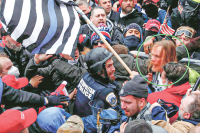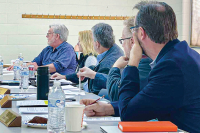Nice threads: WCU Fine Arts Museum exhibit features fiber art instructors and professors from throughout the Southeast
By Michael Beadle
Imagine hundreds of stainless steel threads woven together to make a scarf that looks like silk. An optical illusion of sorts, but nonetheless real and exquisite.
The piece, done by Catharine Ellis, fiber arts instructor at Haywood Community College, is one of 22 works in an exhibit called “Crossing Boundaries,” on display through Dec. 16 at the Fine Arts Museum at Western Carolina University.
The textile pieces include silk, cotton, wool, polyester and other various materials set in both traditional and contemporary designs. They were all created by college instructors, professors, high school educators and guest lecturers who both teach and make fiber art. The 22 artists in the show represent a wide geography of the Southeast from Virginia to the Carolinas, Tennessee down to Georgia and Florida.
Too often artists and teachers are so busy, they don’t have regular contact with their colleagues, so in 2001, Susan Brandeis, professor of art and design at North Carolina State University, helped organize a meeting of all the fiber arts instructors and professors she knew from various colleges around the Southeast. They met at the Penland School of Crafts in Mitchell County and have been meeting annually ever since. The WCU exhibit is part of that cross-country support for each other’s work.
Related Items
Fiber art has enjoyed a resurgence in popularity in recent years though the craft is 10,000 years old. Many recognize the utilitarian use for textiles in items such as bed sheets, quilts, clothing, ropes and fishing nets, but artists today are combining the latest computer technology and synthetic materials with old fashioned weaving techniques to create intentionally nonfunctional works of art that push fiber and art in bold, new directions.
The works in the WCU exhibit include dreamy wall-hangings that range from Jan-Ru Wan’s key-laden jacquard to Jeana Eve Klein’s “Souvenirs,” depicting a ghostly chair and table fixed with symbols scattered across quilt squares. In Jeanne Whitfield Brady’s “Listening for the Words Beneath the Water,” hand-dyed printed silk acts as a kind of page for the diary of cursive words scribbled across the fabric. Mary Babcock, assistant professor of art at Appalachian State University, offers a social critique on marriage with her wedding dress (also embedded with cursive words) encircled with hundreds of wedding rings. Pip Brant, an associate professor at Florida International University, takes a floral-patterned tablecloth and attaches flaming Hummers and recurring elfin boys that sprout flames in each palm. Lighting a fire the viewer can’t escape, “Environmental Liberation Front,” pits nostalgic ’50s sensibilities with millennial eco-politics as gas-guzzlers headline a would-be discussion at the dinner table.
Unfortunately, we only get to see the finished product in this exhibit, the final result of painstaking effort. If Catharine Ellis’ woven steel threads don’t take your breath away just thinking of the sheer Herculean task, perhaps the detailed process for Jeana Eve Klein’s “Souvenirs” will — cotton and recycled fabrics dyed and over-dyed, screen-printed, discharged with a potato dextrin resist, pieced together, painted with acrylic, and hand-quilted with French knots.
Meanwhile, Bethanne Knudson’s jacquard woven with cotton is a busy population of balloon-headed faces while Junco Sato Pollack’s Buddhist-inspired hanging of pieced polyester and silk is a loose arrangement of rectangular logs laid horizontally and vertically.
Patterns in these pieces serve as both a function of design and a point of reference for leaping into experimentation. The fabric acts as a kind of canvas, each thread a paint, each stitch a step in a new direction, until the viewer realizes that fabric has the power to transform. It becomes a window into another world, a portal into the past, a mirror into our most intimate selves. Set aside what you think you may know about fabric art. Step into this exhibit and see fabric in a whole new way.
The WCU Fine Arts Museum is open from 11 a.m. to 6 p.m. on Tuesdays, Wednesdays and Thursdays; 11 a.m. to 4 p.m. on Fridays; and 1 to 4 p.m. on the first Saturday of each month. The museum is closed on Sundays and Mondays. For more information about upcoming exhibits at the WCU Fine Arts Museum, call 828.227.3591 or go to the Web site www.wcu.edu/fapac/galleries.









